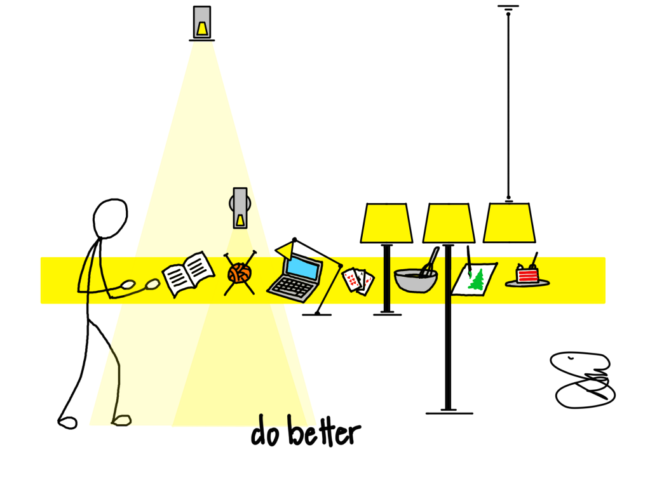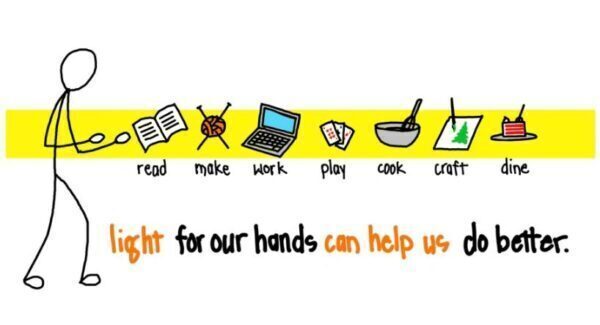Recently our team delivered a continuing education webinar on layers of light for residential and hospitality spaces, a session I have led many times. Each time I revisit the material and update the presentation based on what I have learned since the previous outing.
While preparing for this latest offering, I made a new mental connection between the five promises of light and the specific segments of the human experience associated with each. The five promises- light can help us do better, know more, feel better, focus clearly, and change easily – are the end benefits of better light. They are the why of what we do as lighting professionals. My latest realization is that each promise might also have a subtitle or new phrase – light for something can help you do better, know more, feel better, focus clearly, and change easily.
In the case of the first promise, the new expanded definition is that light for your hands can help you do better.
This new statement tells us more of the what along with the why. We may want to complete our tasks with more ease, more safety, more comfort, more efficiency, or higher quality. Our tasks at home are often completed with our hands- folding laundry, chopping vegetables, packing a bookbag, reading, crafting, and so on. It stands to reason that we need light for this- and that this light needs to be in the right place for our hands.

Sadly, this is most decidedly not what most of us have in our homes. You could say we have light that helps us get headaches, light that helps us feel uncomfortable, light that makes us squint to see our tasks, light that causes our irises and pupils to work overtime. Our homes are full of light up high, near the ceiling, where our hands are not performing their tasks. No one chops a tomato on the ceiling. No one eats dinner above the dining room chandelier. No one crafts above their head.
Most light is, quite simply, in the wrong place, of the wrong kind, or both.
Light can help us see what we are doing so we can do it better, but that means we must have good light for our hands. In my mind, this must be the strongest light in a room, perhaps brightest. It may come from the ceiling, but many of the options for better light for our hands come from somewhere else like a wall or lamp.

Getting the light down low, closer to our hands, has several benefits. First, it gets us stronger light where it is needed. Second, lowering the light source opens up the possibility of locating the source where it will not create glare in our eyes. Even recessed downlights, the workhorse of the well-designed kitchen, can cause glare or eyestrain because it is strong light above our eyes. Finally, light down low can come from a variety of sources, making it possible to get good light for less through strategic use of lamps and task lights.
Most of our homes feature lighting that puts the best light on the ceiling, floor, or in our faces. We concentrate on downlight spacing (“What is the correct spacing for 3” fixtures in a 9’ ceiling?”) instead of thinking about what we need the light for, like our hands. That means we might end up with light that causes subconscious discomfort (we are biologically constructed to dislike light from above- note how our eyes are sunken underneath a shelf and eyebrows to block overhead light). Yes, we might be able to see the kitchen counter. But we will not be able to see it well and that harms our ability to do our best. This gridded layout may be acceptable for gas station pumps, but is it what we need at home?

Light for our hands can help us do better- when it is in the right place for our hands. In the simple diagram of a living room above, light for our hands needs to be in the middle of each seat for reading and knitting and on the coffee table for board games and snacks. This might come from a recessed downlight over the coffee table, but lamps can be better for reading and crafting. The lighting plan is completely different, but much more effective.
Of course, this light is only one of five or six layers of light, or gifts of light, that make a complete environment. Some layers of light might come from the same fixture, but often we will utilize different fixtures to do different things. Recessed downlights and table lamps are simply the beginning.
Light for our hands can help us do better. Strong, shadow-free light on a kitchen counter is ideal for cooking. Strong, low-angled light is ideal for reading or drawing. Each task, each function, has its own best light. But it will almost always be where our hands are.
I will dig a little deeper into light for our hands to help us do better in my next post.
In the coming months I will also dig into the other four promises of light in the Light Can Help Us series. In the meantime, take a look at the ongoing Don’t/Do This series, especially the Kitchens post. Can you spot the light for our hands that will help us do better?
